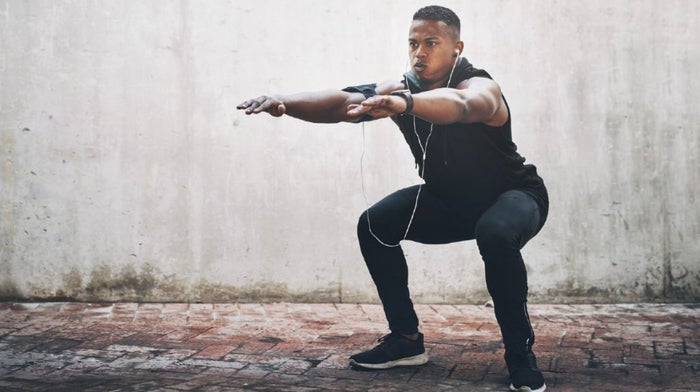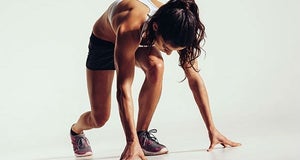
No matter how much people try to deny it - cardio can be a great staple protocol for both fat loss and muscle building goals. That's not implying that everyone should be spending hours a day hammering the treadmill or running until you can no longer breath... unless this is the type of exercise that you enjoy!
If this isn't your idea of fun, or you absolutely dread the thought of spending a chunk of your day on the cross-trainer, why not switch it up for a few bursts of HIIT?
What is High Intensity Interval Training?

HIIT or high-intensity-interval-training is a form of cardiovascular exercise in which extreme bursts of exercise are performed, which is then followed up by short recovery periods.
For example:A 20 second sprint with an intensity of 90% MHR (maximum heart rate) followed by a 10 second rest period, walking or jogging, usually at around 50% MHR and repeat for a total of 20-30 minutes.
HIIT will keep your heart rate up and burns more fat in less time thus making your workouts shorter, yet much more efficient. Studies have shown that a group of females who performed a 20 minute HIIT cardio workout made up of 8-second sprints followed by a 12-second rest period lost six times more bodyfat than a group that followed a 40 minute cardio program performed at a constant intensity of 60% MHR. (1)
Additional benefits of HIIT:
- Improve blood flow within your body
- Eliminate lactic acid build up a lot more fluently
- Ramp up your cardiovascular capacity - making those rests in between sets feel much sweeter!
Who can do HIIT?
The truth is, everybody can do HIIT, but...for all of the beginners out there, whether starting off or coming back from a break from the gym, it's recommended that you build up a good level of fitness before you start any type of interval training. If you exercise often, lead an active life and have a good fitness level already, then you're good to go!
Lose weight & build muscle
Whether your goal is to lose weight or build muscle, HIIT can be very beneficial either way. When using interval training to lose weight, if you stick at it and control your nutrition, you should be able to witness excess weight falling off - you'll reap the rewards and feel so much better too!
Building muscle? Good news – shorter cardio sessions allows you to hold onto more of your muscle. If choosing to stick with steady-state cardio, be aware that it hijacks the fullness and the size of your muscles after exercising for around 30-40+ minutes and nobody wants that do they! Just bear that in mind when preparing for a contest.
A classic example of this is when you compare a marathon runner's body to a sprinter's, take a look at Harry Aikines-Aryeetey's body, the size and fullness of his body whilst being a sprinter having competed in numerous games and championships, placing in first, second and third place in various events. Compare this to the physique and build of UK long distance runner Mo Farah who has as many as 14 gold medals from many events also. Both athletes are exceptional at what they do, however there is a very big size difference and this can be seen very clearly.
How often should I perform interval training?
They say 'too much of something can be bad for you', now that’s up to you to decide, however, due to the pure intenseness of interval training it should be carried out no more than 3 times a week.
A study from the Colorado State University discovered that just 150 seconds – that’s 2 minutes and 30 seconds, of intense exercise can burn up to as much as 200 calories in the following 24 hours whether you're watching television or sleeping, all down to a boosted resting metabolic rate. (2)
How HIIT can be suited to you

HIIT can be performed on a treadmill, bike, rowing machine or pretty much any machine - so take your pick. No matter what machine you choose, the principle of interval training always stays the same, fast explosive bursts followed by calm recovery periods.
When using a treadmill, setting a slight incline will focus and add detail to your hamstrings and glutes, on the recovery periods you can leave it on an incline, but if you're after a more relaxed recovery period, set the incline to zero.
You may want to switch it up by using a choice of machines, it's always good to have a change. Interval training doesn't always have to be performed in a gym environment, it can be done outside, on a track, or anywhere that you feel comfortable.
Take home message
HIIT workouts aren't ones where you can read a book or chat on the phone, they're intense. As the workouts are short, you'll be working hard all the way throughout them. It’s a challenge but you'll see results in no time. Combine interval training and the right diet suited for you and the results you'll receive will be flawless.
HIIT really is something, and if you're looking for a challenge, it's definitely for you!

Get the best results with these HIIT-essentials:
For a detailed look at our top-recommended HIIT supplements, check out our article "Best Supplements for HIIT | Beat the Burn". Alternatively, you can browse a smaller selection below.
Our articles should be used for informational and educational purposes only and are not intended to be taken as medical advice. If you're concerned, consult a health professional before taking dietary supplements or introducing any major changes to your diet.

Related Articles








